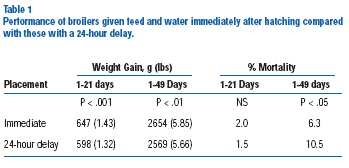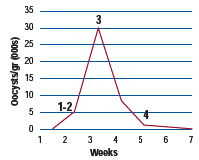Gut decisions
Managing Nutrition to optimise intestinal health programs
As consumers grow more concerned about drugs in poultry
feed and regulators tighten the screws on the range of therapeutics
available, major poultry companies worldwide are
placing more emphasis on vaccination for managing coccidiosis.
This is particularly evident in Europe, where an estimated 9%
of broilers are now vaccinated for this costly and ubiquitous
protozoan disease, a 700% increase over the past 3 years.
The switch from feed additives to vaccination has gone relatively
smoothly, particularly with the development of a special
spray cabinet that ensures uniform distribution of the vaccine
to day-old chicks in the hatchery.
According to Dr. Fabio Paganini of Schering-Plough Animal
Health Corporation, the increasing popularity of vaccination
goes hand-in-hand with another emerging paradigm "that
nutrition can and will play an even bigger role in managing
health challenges.
"As the use of in-feed antibiotics or anticoccidials declines,
producers will no longer be able to depend on these drugs to
suppress the effects of poorly managed environmental conditions
in poultry houses," Paganini says. "Nutrition therefore
needs to be designed to guarantee the development of the
immune system while minimizing the availability of nutrients
for harmful bacteria's growth."
To address this emerging topic, Schering-Plough Animal
Health Corporation recently brought 41 international poultry
producers to New York City for a
technical seminar focusing on the
role of nutrition management in
meeting the contemporary health
challenges of the global poultry
industry.
Conducted in the midst of a blustery
coastal snowstorm that surprised
New Yorkers with more than a foot
of snow, the symposium featured
technical presentations by international
experts and a panel discussion in
which speakers shared front-line
experiences from around the world.
The gathering was an excellent
opportunity for poultry producers to
compare notes on the best strategies
for managing nutritional
programs of birds vaccinated for
coccidiosis. More importantly, it
offered new insights into future directions.
"There were some very enlightening presentations and discussions
during the 2-day meeting," Paganini says. "This is
relevant to poultry producers worldwide."
CocciForum is pleased to present this special report with
highlights from the seminar. To request the full set of seminar
papers, contact [email protected].
Broiler nutrient and energy need as influenced by genetics, nutritional and pharmaceutical environments
 Robert G. Teeter, PhD
Department of Animal Science
Oklahoma State University
Stillwater
|
Achieving optimal performance in commercial
broilers requires specialists in animal
health, nutrition and husbandry to
work effectively together, especially given
the move away from in-feed anticoccidial
drugs.
Genetic progress in the past 50 years
has been impressive. A typical 1950s
broiler reached 1.5 kg (3.30 lbs) with a
feed conversion ratio (FCR) of 3.2 and
took 11 weeks to get there. Its descendant
in the 2000s can make it to 2.3 kg (5.07
lbs) in just 5.5 weeks and an FCR of 1.66.
Despite these gains, and despite the
success of medication to keep it under
control, coccidiosis remains the poultry
industry's most expensive parasite, levying
the world's producers about US$2
billion annually.
Impact of vaccination
Vaccination of birds against coccidiosis,
while effective, is not without cost in
terms of immune challenge and subse-
quent energetic cost "manifested in
greater feed consumption. The impact of
immune stimulation on growth can be
exacerbated by management issues such
as drafts, temperature fluctuations, crowding
and air quality.
Mistakes in these areas can open the
way for infectious agents to overwhelm
the immune system. This could lead to
altered management recommendations to
protect vaccinated birds during brief yet
critical times in the production cycle.
Impacts of drugs
Anticoccidials and ionophores can also
have negative effects. For example, nicarbazin
has been shown to increase mortality
during high humidity-high temperature
stress periods. Ionophores can also have
undesirable consequences. Drugs such as
monensin, salinomycin and lasalocid
affect translocation of ions (hence the
name) across membranes. They can affect
birds' mineral balance and thus water
consumption, which can lead to problems
with wet litter.
The impact of ionophores needs to be
managed within the overall electrolyte
nutrition of broilers. When moving from
an ionophore-based cocci-control program
to vaccination, the feed formulation
needs to be altered for the absence of
ionophores as well as the enhanced
immune system activity.
Nutrition
Nutrition management requires a juggling of priorities for optimizing profit while catering for the energy costs associated with variables such as stocking density, hygiene, lighting and watering systems.
Setting goals
Any formulization program should be
driven by principle goals. These are some
principle goals "and some considerations
if they are to be the focus:
Live body weight and FCR. Without
correct adjustments to protein levels, birds
will develop an over-fat carcass.
Lean mass production
plus breast
and/or specific parts
yield. By slowing
growth of offal protein
and carcass and offal
lipids, live bird mass
and FCR will not be
optimized. Tight management
of non-nutritive
factors is important
to control energy
demands.
Coping with environmental
challenges
that elevate mortality.
The approach is to keep
up carcass growth while
downsizing metabolic demand. It may
take longer for birds to reach market
weight.
Least cost for live weight "lowering
the ration cost. While FCR will fall,
the approach is to provide enough nutrition
for growth to occur, given enough
time. Nutrition standards shouldn't be
lowered to the point that birds are over fat.
The importance of nutrition in the initial phase - developing the intestinal tract and immune capacity
 Antonio Mario Penz, Jr., PhD
Universidade Federal do Rio
Grande do Sul
Brazil
|
There is still considerable room for
improvement in feed conversion ratios,
which means that every year, broilers
must eat less to achieve the same weights.
In terms of nutrition, this puts broilers
on something of a knife's edge when it
comes to achieving their potential. This is
especially so in the first few days of life.
Because broilers are being selected for
lower feed consumption, their immune
systems and very survival face greater
challenges than before.
The digestive tract undergoes major
anatomical changes during the first few
days of life. The passage of feed during
this phase has a big impact on this development
and the way nutrients are
absorbed later in life.
The immune system starts to develop
during the embryonic phase and continues
for the first week after hatching. A
delay in water and feed consumption suppresses
the immune system.
While the yolk sac sustains the newly
hatched chick in the first few hours, it
needs the stimulation of solid feed to get
the digestive system developing properly.
Delaying water and feed during this crucial
period reduces the use of available
nutrients in the yolk sac.
 |
Under practical conditions, chicks arrive at the farm 24-36 hours after hatching. Delays in feeding during transport, sexing and vaccination can affect later development. Conversely, the benefits of early feeding give an advantage that is maintained through to market age (Table 1). It is important, therefore, to put chicks in contact with feed as soon as possible in the first day of life.
Other tips and observations
- The use of lipids in pre-starter diets should be restricted, as animal fat digestibility is very low at this stage. Furthermore, undigested fat could become an energy source for bacteria in the intestine.
- Sodium intake is another important consideration for the first week. Increasing levels of sodium are associated with increased weights due to higher water retention.
- Average particle size in pre-starter diets can affect performance, having an impact on metabolizable energy, nitrogen retention and dry matter retention.
- Addition of protein and fat to prestarter diets can affect abdominal fat percentages by slaughter.
- Restricting water consumption directly affects feed consumption and thus the broiler's performance.
Increasing digestibility using vegetable- and drug-free feed
 Antonio Mario Penz, Jr., PhD Universidade Federal do Rio Grande do Sul Brazil
|
A series of high-profile food scares in
Europe "mad cow disease, antibiotic
resistance and dioxin contamination, to
name a few "has led to tighter regulations
to help restore consumer confidence
in the food sector.
Antibiotics in animal feed and antimicrobial
growth promoters are being
phased out to help reduce the risk of
resistance to antibiotics used in human
medicine.
Banning antimicrobial growth promoters
(AGP) will improve consumer perceptions
but has the potential to create animal
health problems, including:
- Reduced efficiency of feed utilization, especially where management or hygiene standards are poor.
- Increased disease related to Clostridium perfringens, e.g., necrotic enteritis (NE), chronic hepatitis.
- More wet litter problems because of increased NE.
Given the high use of wheat and barley
in European poultry diets, feeding
programs and feed composition may be
important factors in disease when AGP
are withdrawn. The soluble non-starchpolysaccharides
(NSP) in these cereals can
cause a range of digestive problems, especially
in rye-based diets where elevated
numbers of C. perfringens are reported.
NSP-degrading enzymes are used to mitigate
this problem.
Diet is also an important factor in coccidiosis,
and Spain's department of animal
nutrition has been studying the relationship
between feed components and coccidiosis
vaccination with Schering-Plough
Animal Health.
The study compared performance of
vaccinated birds on
US-type corn-based
diets with European
wheat- or rye-based
diets (with or without
the NSP-degrading
enzymes). Different
nutritional strategies
to improve performance
of birds vaccinated
against coccidiosis
were also
studied.
Performance
issues relating to the
age in vaccinated
birds and their feed
programs have been
identified, but it
appears that improving the digestibility of
European broiler diets (e.g., through
enzymes) could enhance the performance
of vaccinated birds. Better digestibility will
also help reduce the impact of C. perfringens
and others.
Control of necrotic enteritis in drug-free birds
 Magne Kaldhusdal, PhD
National Veterinary Institute
Norway
|
Research and development for the production
system is based on in-feed
antibiotics used for managing necrotic
enteritis (NE). Their eventual abolition
will require a more multidisciplinary
approach, especially for dealing with NE
associated with Clostridium perfringens.
Many factors directly and indirectly
affect the severity of C. perfringens-associated
problems. Understanding and learning
how to manage them is the key. It is
clear that much more research is needed
to understand the mechanisms and
efficacy of alternative methods for NE
control.
Coccidiosis control. Coccidiosis predisposes
birds to NE. Commercially, vaccinated
birds are protected from coccidiosis
and perform on par with medicated
birds. However, additional measures to
protect against NE are needed in vaccinated
(non-medicated) birds.
Digestibility for young birds. Digestibility
is not very relevant for young
birds protected by in-feed medication,
but it becomes significant when the
antibiotics are removed. High digestibility
is important to prevent the accumulation
of a substrate that favors development
of C. perfringens.
Dietary fat. Young birds digest some
fats better than others and this can
affect levels of C. perfringens.
Cereal type. Wheat- and barley-based
diets appear to encourage greater proliferation
of C. perfringens than corn-based
feed. The action of dietary enzymes on
the cereals may be implicated. Plant
breeding might be used to optimize
performance of different cereals in this
respect. However, more research is
needed into the mechanisms of this
relationship between cereal type and
NE risk.
Cereal storage. The length of storage
(longer is better for wheat and barley)
and the method of storage (air-tight for
barley and oats), seem to have a positive
effect on digestibility.
Dietary protein source. Diets high in
protein, especially non-digestible protein,
favor growth of C. perfringens.
Feed processing. Many factors in feed
processing affect vulnerability to NE.
These include use of pelleting, which
appears to have both positive and negative
effects. Heat affects digestibility and
could open the door for C. perfringens
by killing less-resilient competitors.
Particle size can be a factor in digestibility
for some ingredients.
Whole grain feeding. Whole grain
wheat can reduce C. perfringens counts,
but it is not known why.
Microbial cultures. These may help
resist the onset of NE by quickly establishing
healthy cultures of gut flora in
young birds. Microbial cultures can also
encompass probiotics which include
microorganisms and some of their products.
Prebiotics. These are food ingredients
that encourage the development of beneficial
bacteria in the hindgut.
Supplementary enzymes. These are used
to optimize digestive function. It is not
clear whether these are directly useful
for preventing NE.
Plant products. Some plant products
such as essential oils appear to reduce
counts of C. perfringens, but more work
is needed to support their use against
NE.
Immunity. Maternal antibodies against
C. perfringens seem to protect birds
from NE for the first 2-3 weeks. On the
strength of this, there could be potential
for a vaccine to stimulate maternal or
active immunity and contribute to NE
control.
Management. The "farm effect" of stocking
density, lighting programs, feeding
methods and the state of litter all contribute
to the NE status of a poultry operation.
Infection sources. C. perfringens spores
are very difficult to kill, and survive disinfectant
treatments between grow-outs. It can be carried in feed, but there are
numerous environmental sources.
Economic advantage of managing nutrition in coccidiosis-vaccinated broilers
 Phillip Hargis, PhD
Hargis Associates
USA
|
In terms of economy, coccidiosis vaccination
is competitive with using in-feed
anticoccidials, but a few changes must be
made to feed formulation, feeding program
and broiler-house management to
ensure success.
Do not expect performance of vaccinated
broilers to exceed performance in
programs using ionophores and/or chemical
drugs. The cost of production will be
the same for either option.
The most economically feasible strategy
is to use conventional drug programs
with lighter birds (1.7 kg "� 1.9 kg/3.75 "�
4.19 lbs) and coccidiosis vaccination programs
along with conventional programs
for birds taken through the heavier
weights.
There is only so much a feed program
can do to enhance the effectiveness of
vaccination. In addition to nutrition, there
are several other key factors in the success
of a coccidiosis vaccination program:
Time of year. It's best to introduce
vaccination between April 1 and
November 1, when houses are dry and
challenge low. Year-round use can be
phased in later.
House management. Litter condition
is crucial; so is the ability to control environmental
conditions.
Lighting. No dark periods to limit feed
intake and no continuous bright lights to
overstimulate activity and utilization of
nutrients, thus over-taxing the coccidiosischallenged
gut.
Genetics. Birds that feed well in early
life do better under vaccination programs.
Where regular drug programs also
involve vaccination, there are critical
"companion drugs." Likewise, there are
important companion ingredients such as
sodium bicarb, phytase and betaine.
Feed formulations to support vaccination programs
Vaccinated birds need time to overcome
the early coccidiosis challenge. Once the
second challenge is passed, the formulation
should maximize growth from day 30
on. Before this, there are two critical periods:
17-21 days and 27-30 days. Feed for mulation must be closely controlled with
no changes at these times.
Some other important tips for nutrition
programs are:
- Use high-digestibility ingredients
- Use ingredients low in peroxides and gut-corrosive properties
- Minimize mycotoxin exposure
- Minimize bird stress via ingredient quality
- Minimize ingredients that promote intestinal fermentation
- Avoid feed reformulations or switching to cheaper ingredients.
Integration with ionophore drugs
Coccidial vaccines "revive" over-used and abused ionophores. Take advantage of this by following a vaccination cycle with the weakest in the current drug program.
Nutritional programs to optimize performance in drug-free diets "the Brazilian experience
 PRonei Gauer, PhD
Nutrition Consultant
Brazil
|
Each 1 kg (2.2 lbs) on a Boeing 767 consumes
an extra 200 liters (52.8 gallons) of
aviation fuel per year. In the broiler
industry, the extra "weight" in a diet can
also drag down productivity.
In Brazil, two factors are leading to the
demise of coccidiostats and growth promoters
in poultry feed: consumer resistance,
and declining efficacy. Doses of
anticoccidials have been increased to
combat resistance to antibiotics.
The investment in drugs has diverted
poultry industry investment from more
productive lines of research, such as feed
and water quality, and training of personnel.
In Brazil, a number of strategies have
now been identified to help maximize
performance in drug-free production systems
that employ vaccination against coccidiosis:
Quality of ingredients. Higher quality
raw material improves digestibility and
leaves less substrate for bacterial development.
Particle size. Whole cereals can stimulate
the gizzard and may help with
digestion and suppression of salmonella.
Feed processing. Temperatures and
pressure can affect feed absorption.
Organic acids. These can impede the
invasion of birds by bacteria.
Protein/enzymes. Minimizing nonabsorption
of protein denies bacteria such
as Clostridium perfringens a substrate for
development. Enzymes help maximize
protein absorption.
Betaine. This helps decrease incidence
and severity of intestinal lesions in vaccinated
birds and could help improve feed
conversion rates.
Differentiated diets. Weight gain,
pigmentation and feed conversion can be
issues in vaccinated birds if diets are not
adjusted appropriately at crucial periods
"for example, reducing protein levels in
starter feed (10-20 days).
Pre-starter feed. This should be used
until immunity builds up. High-quality
ingredients are essential.
Starter feed. Lower levels of crude
protein are required as the immunitybuilding
process peaks. This helps control
bacterial growth.
Variability. With more digestible feed
and more consistent quality and other
refinements such as enzymes, it will be
possible to minimize bacterial challenge
that was previously controlled with
antimicrobial growth promoters. Work is
also needed to improve management of
the basics (e.g., water quality) among the
poorest producers.
Taken together, the strategies are
tipped to offer a cumulative FCR improvement
of 0.18 g per kg of gain (0.0008 per
lb).
PRESENTER:
Amatzia Eyal, PhD
Nutrition Consultant
Israel
Nutritional programs to optimize performance in anticoccidial-free diets "the Israeli experience
 Amatzia Eyal, PhD
Nutrition Consultant
Israel
|
Comparative trials in Israel have shown
very similar performance results for coccidiostat-
treated birds and birds vaccinated
against coccidiosis.
The birds were split into male and
female groups, with different feed
regimes for the vaccinated and medicated
birds. The vaccinated birds received diets
designed to reduce mortality and feed
cost without compromising performance.
The feed for both groups was based on
corn and wheat because of the Israeli
market requirement for white skin.
In both the male and female groups,
finished weights were very similar for
vaccinated and medicated birds.
An interesting result for both the male
(+42 g/+0.092 lb) and female (+30 g/
+0.066 lb) birds was that vaccinated animals
yielded more breast meat than the
medicated birds, but the reason has not
been determined.
Alternative feed programs in broilers vaccinated for coccidiosis "the Spanish experience
 José Ignacio Barragan, DVM
Nutrition Consultant
Spainl
|
Traditional feed programs in Spain are
designed around the withdrawal period
from a coccidiostat. Using a vaccine that
provides lifelong immunity instead of an
in-feed anticoccidial has allowed producers
to focus on managing feed ingredients
for optimum performance "without
worrying about drug treatment or withdrawal
times.
The added flexibility allows operations
to:
- Provide the right start for broilers with the highest possible feed digestibility during the crucial 14-28 day period.
- Use lower-cost finishing rations for longer periods, without compromising production.
Trial 1: Use of high-digestibility rations at an early age
The trial compared performance using the conventional starter (0-20 days), grower (21-42 days) and finisher (43-49 days) program with an alternative that split the 0-20 day program into two phases "a pre-starter and starter feed. The aim was to optimize the pre-starter period performance and to promote digestibility during the starter period with a less concentrated feed.
For the total study (0-49 days), the final weight of vaccinated broilers on the alternative feed program was clearly better than weights for medicated birds on a conventional diet. There were no significant differences in mortality or real feed conversion indexes.
Trial 2: Use of different finisher diet periods
The trial split vaccinated birds into conventional and alternative starter programs as in the first trial, but also looked at the impact of varying the finisher feed periods. A medicated group was also tested.
The study concluded that it is practicable to prolong the use of finisher diets without impairing final performance - something that might reduce the cost of feeding programs for vaccinated broilers.
Trial 3: Combined studies 1 and 2
A trial at the IRTA experimental station revisited the impact of digestibility at earlier stages as well as using feeding finishing diets for longer periods with some refinements.
Once again, the trial confirmed that with correct husbandry and ambient conditions, performance of vaccinated broilers matches that of medicated birds. Interestingly, both vaccinated and medicated birds benefited from the alternative feed programs. It also demonstrated the benefits of using alternative diets in vaccinated birds.
In vaccinated chickens, longer finisher/ withdrawal diet periods at a lower cost did not compromise weights, mortality or feed conversion ratio (FCR), nor did it increase risk of late coccidiosis outbreaks. The results were consistent with practical experience in Spain.
Managing nutrition for coccidiosis-vaccinated birds - UK trial results and novel marketing concepts
 Peter Woodward, BSc
Poultry Nutrition Specialists
Hereford, UK
|
Over the past several years, there has
been a series of small-scale and commercial-
scale trials to explore ways to maintain
gut health in chickens vaccinated
against coccidiosis in the UK and Ireland.
Small pen trials in the UK in 2000-01
aimed to develop a nutritional program
for vaccinated birds that provided performance
at least equal to conventionally
raised chickens and at a comparable cost.
Despite increased mortality, the best
economic performance was observed
with vaccinated birds on high-density
starter diets with high-quality proteins.
Protein source (fishmeal or soya meal)
was not a factor. Savings in feed cost offset
the cost of vaccination.
Further trials in Ireland last year
looked at the effects of raw materials and
dietary additives in the diets of vaccinated
birds.
In the first trial, some of the bioflavonoid
additives showed potential synergistic
responses. In trial 2, vaccinated
birds were given either vegetable or fishmeal
protein sources. As long as nutrients
were balanced following removal of fishmeal
from the diet, there were no nutritional
factors interfering with the birds'
response to vaccination.
Trials have also been held in a UK
commercial environment over the past 2
years. The farm chosen had experienced
a range of health problems including clinical
coccidiosis. Performance of vaccinated
birds was inconsistent, although
improvements were noted with subsequent
crops.
It was concluded that more needs to
be known about the dynamics and factors
critical for vaccination. It was also noted
that successful and economic performance
using vaccination against coccidiosis
will be achieved through combinations of
feed manipulations and modifying management
standards.
A nutritional concept for vaccinated birds "IDEA program
 César Carnicer, PhD
Poultry Business Manager
Schering-Plough Animal Health
Spain
|
The research results from Spain presented
by Dr. Barragan (page 15) indicated that
nutrition programs for vaccinated birds
are free from the constraints imposed by
withdrawal times. As such, they can be
adapted to better suit their nutritional
needs and the producers' economic
needs.
Dr. Carnicer developed this theme by
proposing a good "IDEA" in the form of a
nutrition program that fits the dynamics of
Eimeria spp. during the production cycle
of vaccinated birds.
The accompanying graph shows the
classical oocyst-excretion curve of wellmanaged,
vaccinated birds. There are
three oocyst cycles, with peak production
occurring typically during the third, at 21-
28 days.
 |
Good uniform vaccine coverage is
essential to ensure that all birds begin the
cycling process together, which in turn
leads to uniformity in oocyst cycling and
immune development.
Equally important to the success of a
coccidiosis vaccination program is the
overall quality of poultry house management.
This includes everything from
cleanout before the introduction of a vaccinated
flock, to bedding, temperature
control, litter moisture, flock density and
warmth.
By adapting nutrition programs to the
physiological situation in the intestine of
vaccinated birds and matching nutrient
needs to the building of immunity in each
period, vaccinated birds will perform better.
This is spelled out in the IDEA concept:
I: Impulse phase (1-2 in graph). Prepare
the immune system and intestinal cells to
develop immunity against coccidiosis; at
the same time an adequate start for the
fattening period is provided.
D: Digestibility or Developing phase (2-
3) in graph). Help the immune system
and intestinal cells build immunity. This is
important not only for coccidiosis, but
also because most intestinal infectious
problems and disturbances occur in this
period.
E: Economic advantage (4 in graph).
Take advantage of birds' immunity against
coccidiosis with good intestinal health.
A: An Advance in poultry farming and a
good Alternative for the new era when
in-feed additives will no longer be available.
Source: CocciForum Issue No.8, Schering-Plough Animal Health.







